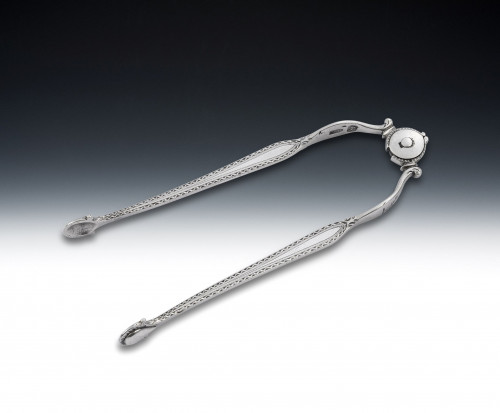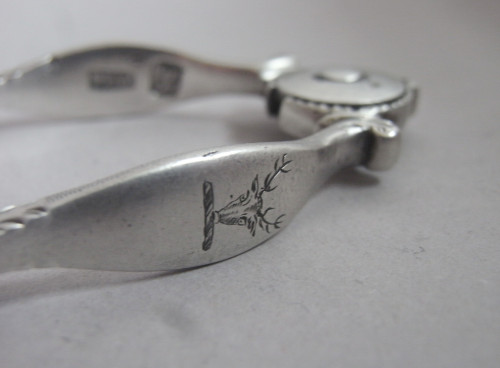- Home
- British Silver 1760-1830
- Naval Interest. Vice Admiral Sir Henry Hotham. A fine George III gOBLET MADE IN lONDON IN 1789 BY hENRY cHAWNER.
Naval Interest. Vice Admiral Sir Henry Hotham. A fine George III gOBLET MADE IN lONDON IN 1789 BY hENRY cHAWNER.
Naval Interest. Vice Admiral Sir Henry Hotham. A fine George III gOBLET MADE IN lONDON IN 1789 BY hENRY cHAWNER.
375213
The Goblet is modelled in a Classical form with circular pedestal foot, with reeded edge, engraved with a beautiful outer band of scrolls and stylised foliate motifs on a scratch engraved ground flanked by prick dot bands. The vase shaped bowl has a deeply gilded interior and the front displays one of the most finely engraved Armorials we have seen. The Arms are unusually engraved accole, that is in linked ovals side by side. This is a design which is not often seen, however the effect is very beautiful. The Arms have the associated Crest above and the motto engraved on a banner below. The heraldry is all surrounded by a pluming foliate scroll cartouche. This piece is in quite exceptional condition and is very well marked in the foot. This piece is of a good large size and would hold a decent quantity of wine.
We have traced the Armorial, Crest and Motto and they are those of Hotham, with Hotham impaling Rouse. They are specifically those of Vice Admiral Sir Henry Hotham KCB GCMG (19th February, 1777 - 19th April, 1833) who was the 3rd son of the 2nd Baron Hotham. On 6th July, 1816 he married Lady Frances Anne Juliana Rous, the only child of John Rous, 1st Earl of Stradbroke. They had three sons. Sir Henry Hotham was a Naval officer in the French Revolutionary Wars, the Napoleonic Wars, the War of 1812 and the campaign on Napoleon's escape from Elba.
On 25 March 1818 Hotham was appointed a member of the Board of Admiralty, his position being renewed in March 1819 and February 1822, serving until March 1822. On 28 May 1825 he was promoted to vice-admiral, and returned to serve on the Board of Admiralty in September 1828, renewed in June 1829 and July 1830, until November 1830. He was appointed Commander-in-Chief in the Mediterranean on 30 March 1831, and on 4 July 1831 was made a Knight Grand Cross of the Order of St. Michael and St. George.
One of Hotham's more notable acts as Commander-in-Chief was claiming a new territory for Britain. In July 1831 Commander Charles Henry Swinburne of Rapid reported a volcanic eruption and a column of vapour rising from the sea, some 26 miles off Sciaccia, Sicily. Within a month it had grown into a roughly circular island of black volcanic sand about 3 miles (4.8 km) in circumference, and 74 feet (23 m) above sea level at its highest point. Hotham, in his flagship St. Vincent, sailed to the new island and on 1 August sent his flag-captain Humphrey Senhouse ashore with a landing party to raise the Union Flag, and claim the island for Britain under the name "Graham Island", after the First Lord of the Admiralty, Sir James Graham. Later the Sicilians also landed, hoisted a flag, and claimed the island under the name "Ferdinandea", after King Ferdinand II of the Two Sicilies . The French made a claim to the island under the name "Julia", as did the Spanish. Diplomatic arguments continued until December 1831, by which time the island had been washed away leaving something only 26 feet (7.9 m) below the waves.
Hotham died suddenly in Valletta, Malta, on 19 April 1833, and was buried at Msida Bastion Cemetery in Floriana on 24th April. A portrait of the Vice Admiral by Samuel Lane, 1780-1759, is shown in the image stream.
Height: 6.65 inches, 16.63 cm.
Diameter at the rim: 3.75 inches, 9.38 cm.
Weight: 11oz.
Thank you for your enquiry.
We will get back to you soon.
Please create wishlist to add this item to
RELATED ITEMS




























